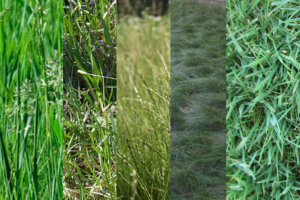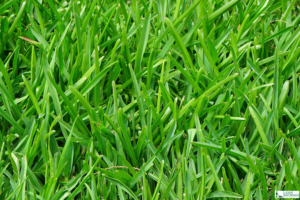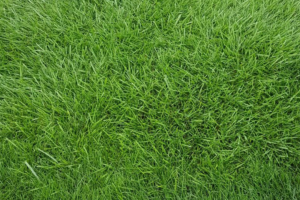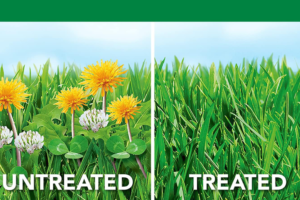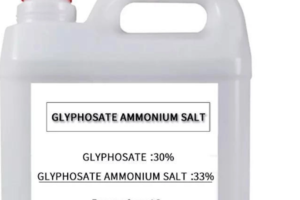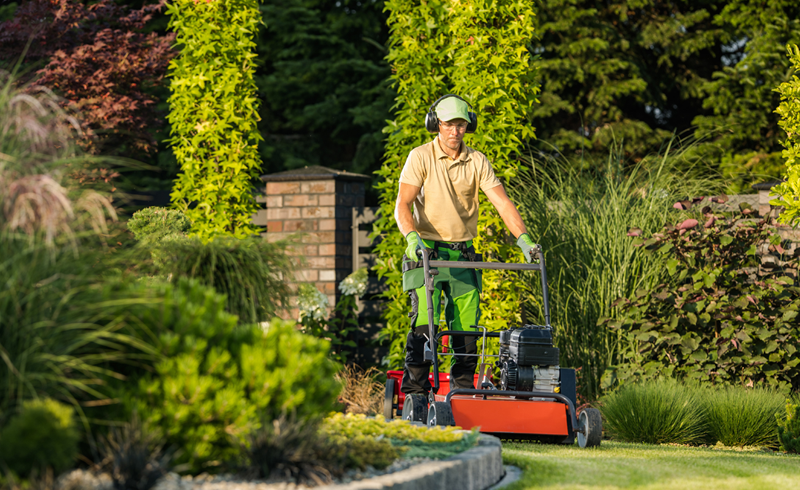
August is the time of year when your lawn is in full bloom. It’s a beautiful sight, but you’ll need to roll up your sleeves and do some work to stay that way. Start by taking stock of your lawn – is it lush and green, or is it starting to show signs of trouble? Proper care and maintenance allow you to keep your property looking its best all summer.
Think of it as an investment in your home. As the saying goes, “A stitch in time saves nine.” Taking care of your lawn now will save you time and money in the long run. This article discusses mowing, watering, fertilizing, aerating, weed control, pest management, and how to fix bald or brown spots. We’ll also discuss ways to cut back on lawn fungus. So let’s get started – it’s time to give your lawn the attention it deserves.
Key Takeaways
- Mow your lawn regularly at a height of about 3 inches to maintain a healthy density and shade out weeds.
- Mulch your lawn with clippings to add nutrients to the soil and prevent weeds.
- Water your lawn deeply but infrequently, aiming for 1-2 inches per week.
- Fertilize your lawn with a balanced fertilizer containing nitrogen, phosphorus, and potassium according to the instructions on the package.
Mowing Your Lawn
Mowing your lawn in August isn’t just a chore – it’s an opportunity to keep your grass looking lush and healthy! Before you fire up the mower, check the blades for proper sharpness. Dull blades can tear the grass, leaving it vulnerable to disease and insects. Once you’ve got a sharp blade, mow your lawn regularly at about 3 inches. This will help grass maintain a healthy density and shade out unwanted weeds.
When you’re done mowing, consider mulching your lawn with clippings. This adds nutrients to the soil and helps to prevent weeds. Consider a de-thatching technique to help the grass grow thicker if your lawn looks thin.
Watering your lawn is a vital part of keeping it healthy and strong. The key to successful August lawn care is to water deeply but infrequently. Water your lawn in the early morning when the sun is low and the temperatures are more relaxed. This will help reduce the amount of water that evaporates and waste. Aim for 1-2 inches of water per week, depending on the weather and the type of grass you have.
If your lawn looks dry or brown, consider adding a layer of mulch to help retain moisture. This will help keep your grass looking lush and healthy throughout the summer. Investing some time and effort into lawn care in August ensures your lawn looks great all season. With a little bit of TLC, your lawn will be the envy of the neighborhood.
Watering Your Lawn
Watering your grass regularly is critical to keeping it lush and green, like pouring liquid gold into your backyard! Watering your lawn weekly is necessary to ensure it stays healthy in August. The watering frequency may vary depending on the type of grass and the region, so it’s essential to do some research to find out what works best for you.
You may water by hand, using a hose or sprinkler, or using an automated irrigation system to make it easier. If you water by hand, ensure you do it in the morning so the grass has plenty of time to dry before nightfall. If you use an irrigation system, check it periodically to ensure it works correctly.
Here are the key elements to consider when watering your lawn in August:
- Watering Frequency. Depending on the type of grass and the region, this may vary, but generally, weekly is sufficient. Watering Time. Early morning is best, so the grass has plenty of time to dry before nightfall.
- Watering Method. You can water by hand, using a hose or sprinkler, or using an automated irrigation system.
- Irrigation System Maintenance. If you use an automated irrigation system, check it periodically to ensure it works properly.
Watering your lawn correctly in August will help ensure a lush, green lawn throughout the rest of the summer. Getting the watering frequency and method right will help ensure your lawn stays healthy and vibrant. With the proper care, your lawn will be the envy of the neighborhood! Fertilizing your lawn is the next step in keeping it healthy and vibrant.
Fertilizing Your Lawn
Fertilizing your grass is the key to maintaining its lushness and vibrant color, so remember to give it the nourishment it needs! Preparing the soil before planting is essential to ensure optimal growth and health of your lawn. You should take the time to select the correct type of grass for your area, as different grasses have different nutritional needs. To fertilize your lawn, you should purchase a balanced fertilizer that contains nitrogen, phosphorus, and potassium.
Apply it to your lawn according to the instructions on the package, as too much fertilizer can lead to burnt patches or even kill your grass. Additionally, be sure to water your lawn after applying fertilizer, as the water helps it absorb nutrients. When fertilizing your lawn, timing is critical.
Fertilizing in the late summer can boost your grass, helping it stay strong and healthy throughout the fall. However, it is essential to fertilize your lawn occasionally, as this can cause the grass to become overly saturated with nutrients. Additionally, applying too much fertilizer can make it more vulnerable to disease and pests, so doing just what is necessary is essential.
Finally, please make sure to mow your lawn regularly and keep it debris-free. This will help your lawn absorb the fertilizer and keep it healthy. Taking the time to fertilize your lawn properly will go a long way in ensuring its health and beauty. With some extra care and attention, your lawn will be the envy of the neighborhood! Moving on to the next step of aerating your lawn, you will be closer to having the perfect lawn.
Aerating Your Lawn
To keep your grass looking its best, remember to give it a breath of fresh air occasionally with some aerating! Aerating your lawn is a simple and effective way to ensure the grass gets the oxygen and water needed to remain healthy and lush. It also helps break up compacted soil, preventing water, fertilizer, and other nutrients from reaching the roots.
Benefits of Aerating:
- Improves drainage:
- Reduces standing water
- Allows water to reach roots
- Breaks up compacted soil
- Increases air and water absorption
Aerating Tips:
- Consider over-seeding your lawn after aerating.
- Have your soil tested before aerating to determine the best action.
- Avoid aerating during extremely hot or dry periods to reduce stress on the lawn.
Aerating your lawn is easy and inexpensive to improve its health and appearance. It is a simple process that can be done at home with a garden fork or a unique tool such as a core aerator. The process can be done every one to two years, depending on your soil type and lawn condition. Remember, aerating your lawn is only one piece of the puzzle regarding lawn care. You must fertilize, water, and control weeds to keep your grass looking its best. Giving your lawn the necessary care will result in a healthier, better-looking lawn lasting for years.
With proper aerating and maintenance, your lawn will look its best and be ready for those warm summer days. Let’s move on to the following lawn care step: weed control.
Weed Control
Keeping pesky weeds at bay is essential for maintaining a healthy lawn! Fortunately, several preventative measures can be taken to control weeds in your yard. One of the best ways to keep weeds from invading your lawn is to mow regularly. Regular mowing discourages weed growth by eliminating the light they need to germinate. Additionally, it is essential to keep your lawn well-fertilized. This helps create a healthier turf that can better crowd out weeds.
Weeds can also be removed by hand. This is a tedious task, but it is the most effective way to eliminate existing weeds. Please keep in mind that when you’re pulling weeds, you’ll need to be sure to remove the entire root system. Otherwise, the weed will only grow back. Finally, several natural remedies can be used to control weeds. Applying a solution of vinegar and water can help kill weeds. A salt solution or boiling water can also be applied to kill weeds and prevent them from returning.
While these methods may help keep weeds from invading your lawn, it is essential to remember that they are preventative measures. If weeds have already taken hold, they may need to be handled differently. Fortunately, dealing with these pests is the next step.
Dealing with Pests
Controlling pests can be tricky, but several ways exist to tackle the issue. First, plant diverse plants to create natural pest control. Add beneficial insects to your lawn, such as ladybugs, praying mantis, and lacewings. Third, stay on top of regular lawn care, such as mowing and watering, to keep the pests away. Lastly, use natural products such as insecticidal soaps, garlic sprays, and citrus oils to keep pests away.
- Plant a diverse selection of plants
- Add beneficial insects
- Stay on top of regular lawn care
- Use natural products
These are all great ways to naturally control pests in your lawn. Taking these steps can help ensure that your lawn stays healthy and pest-free. Natural pest control will also help ensure your lawn is safe for your family and pets. Not only can pests be a nuisance, but they can also be destructive to your lawn. Taking the necessary steps to control pests in your lawn is essential for maintaining the health of your lawn.
To sum up, there are many ways to control pests in your lawn. Planting a diverse selection of plants, adding beneficial insects, staying on top of regular lawn care, and using natural products are all great ways to naturally control pests in your lawn. Taking these steps can help ensure that your lawn stays healthy and pest-free. Fixing bald or brown spots in your lawn is the next step in keeping it healthy and looking its best.
Fixing Bald or Brown Spots
Fixing bald or brown spots in your lawn is essential for maintaining its overall health and beauty. These spots are usually caused by overuse, pest damage, or inadequate watering. You can start by giving the affected area more grass seed to fix these issues. This will help to thicken the lawn and fill in the bald spot.
It would be best to topdress the patch with a thin layer of soil. This helps to promote the growth of the new grass seed and prevent it from washing away. It is also essential to ensure the soil is moist for proper germination and development of the new seed. You should water the affected area twice daily, for about 15 minutes each time. Be sure to use a low-pressure setting, as too much pressure can cause the seed to wash away.
Also, you should avoid getting rid of the new grass seed until it has a chance to grow. You can also use a fungicide to prevent fungus and other diseases from damaging your lawn. By using a fungicide, you can keep the grass healthy and robust. This can also help to prevent bald or brown spots from returning.
With the proper care and attention, you can restore the health and beauty of your lawn. You can eliminate bald or brown spots by overseeding, topdressing, and watering your lawn correctly. You can also apply a fungicide to prevent fungal infections and make sure the new seed has a chance to grow. Moving forward, you can take steps to avoid fungus and maintain your lawn’s health.
Cutting Back on Lawn Fungus
To prevent lawn fungus, you need to take proactive steps, but some people may worry that this requires costly treatments – however, you can use plenty of affordable strategies. Maintaining a healthy lawn is the best way to prevent lawn fungus, and the following preventative treatments should be considered:
- Watering: Water only when necessary Avoid over-watering
- Fertilizing: Use fertilizers with high nitrogen content. Avoid over-fertilizing
- Monitoring: the conditions of your lawn are also necessary. Make sure to mow regularly, as this will help keep the grass healthy and reduce the risk of lawn fungus.
Also, please watch for any signs of fungal growth, such as discolored or wilted patches of grass. If you notice these signs, please prevent the fungus from spreading. In addition to these preventative treatments and monitoring, you should regularly aerate and dethatch your lawn. Aerating will help the soil absorb more water and nutrients, while dethatching will help remove dead grass and debris. Both of these procedures can help reduce the risk of lawn fungus.
Taking proactive steps to prevent lawn fungus is essential for maintaining a healthy lawn. You don’t need to spend much money to keep it healthy, as you can use plenty of affordable strategies. You can help protect your lawn from fungus and keep it looking its best through preventative treatments, monitoring conditions, and regular aerating and dethatching.
Frequently Asked Questions
What type of lawn mower should I use?
When deciding what type of lawn mower to use, it’s essential to consider your grass and your preventive maintenance routine. A riding mower is ideal for larger areas, while a push mower is better for smaller spaces. A self-propelled mower may be best for dealing with tall grass and weeds. You’ll also want to consider the size of the mower’s cutting deck and the power of its engine. Finally, could you consider the fuel type you prefer and the cost of the mower? With a bit of research, you’ll be able to find the right mower for your lawn care needs.
How often should I water my lawn?
Watering your lawn is an essential part of maintaining its health and beauty. How often you water your property depends on the type of grass you have and the weather conditions. Generally, lawns need to be watered deeply and infrequently, with about 1 inch of water per week being the optimal frequency. You can use a sprinkler system or manual irrigation techniques like hand watering, soaker hoses, and drip irrigation to water your lawn. You may need to water your lawn more often during high temperatures and drought.
What type of fertilizer is best for my type of lawn?
You may be wondering what type of fertilizer is best for your lawn. As with anything, there is no one-size-fits-all answer. Finding the right fertilizer for your lawn is a fit-and-finish matter like a well-crafted suit. Consider using organic fertilizer for a lush, green lawn. It’s like giving your lawn a vitamin-packed meal that will nourish it throughout the season. Consider using a mulching mower to get the most out of your organic fertilizer. This cuts your grass and leaves behind tiny clippings that are a natural fertilizer for your lawn. You can have a beautiful and healthy lawn with patience and care.
How do I know if my lawn needs aerating?
If you’re considering aerating your lawn, the first step is determining if aerating is necessary. Aeration is recommended when the soil is compacted. Signs that your soil is compacted include slow growth, thinning grass, and poor drainage. To determine the timing and frequency of aeration, consider the traffic your lawn receives and the type of soil you have. Aerating too often or too little can negatively affect your lawn’s health, so finding the right balance is essential.
Is there an environmentally friendly way to control weeds?
Yes, there are non-toxic and natural remedies to control weeds. To start, you can try manually removing them from the soil. This can be tedious, but it’s an effective way to keep weeds under control. Additionally, you can use mulch to limit their growth. As a bonus, this also helps retain moisture in the soil. Furthermore, you can consider using natural herbicides or vinegar to help eliminate weeds. These are all viable options that are environmentally friendly and will help keep your lawn weed-free.
Conclusion
Wrapping up your August lawn care routine doesn’t have to be a chore. Sure, it’s a lot of work, but you can take pride in giving your lawn everything it needs to thrive. That said, it’s important to remember that a perfect lawn isn’t always a reality. So if you don’t get the results you were hoping for, don’t despair. Keep on working, and you’ll get there!

Bob Green, a passionate lawn care enthusiast with over two decades of landscaping experience, is this website’s proud owner. His vast knowledge of horticulture and dedication to helping homeowners maintain beautiful lawns are reflected in the valuable content he shares on his platform. John has always been interested in Agrostology.









